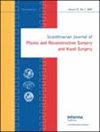Displacement of the bar after minimally-invasive repair of pectus excavatum.
Scandinavian Journal of Plastic and Reconstructive Surgery and Hand Surgery
Pub Date : 2010-04-01
DOI:10.3109/02844310903569709
引用次数: 4
Abstract
Abstract The most common complication of the minimally-invasive technique for the repair of pectus excavatum is displacement of the bar, and it may cause retraction of the chest. We aimed to find out if there was any factor that could predict displacement of the bar after operation. The records of 12 patients who were operated on for repair of pectus excavatum at the Osaka Medical College between December 1999 and August 2006 were analysed. Their mean age was 9 years (range 4-21). The mean Haller computed tomographic (CT) index was 4.9 (range 3.8-6.9). To predict the risk of postoperative rotation of the bar we considered patients' age, Haller CT index, intercostal distance where the pectus bar passed through, and the depression index. The bar was displaced in four patients, and there was a significant difference in depression index between those in whom the bar was displaced (n=4) and those in whom it was not (n=8). In the displacement group, it ranged from 25% to 38% (mean 32%), and in the undisplaced group from 15% to 27% (mean 18%). There was a significant difference between the groups (p< 0.01). Rotation of the bar is thought to be closely related to its stability at the deepest point of the depressed sternum. The depression index is useful in predicting the risk of rotation of the bar.漏斗胸微创修复后椎棒移位。
微创技术修复漏斗胸最常见的并发症是椎弓根移位,它可能导致胸后缩。我们的目的是找出是否有任何因素可以预测手术后杆的位移。对1999年12月至2006年8月在大阪医科大学行漏斗胸修复手术的12例患者的记录进行了分析。平均年龄9岁(范围4-21岁)。平均Haller计算机断层扫描(CT)指数为4.9(范围3.8-6.9)。为了预测胸棒术后旋转的风险,我们考虑了患者的年龄、Haller CT指数、胸棒穿过的肋间距离和凹陷指数。有4例患者的横条移位,横条移位组(n=4)与未移位组(n=8)的抑郁指数有显著差异。在流离失所组中,这一比例从25%到38%(平均32%)不等,在未流离失所组中,这一比例从15%到27%(平均18%)不等。两组间差异有统计学意义(p< 0.01)。棒的旋转被认为与它在胸骨凹陷最深处的稳定性密切相关。凹陷指数在预测柱的旋转风险方面是有用的。
本文章由计算机程序翻译,如有差异,请以英文原文为准。
求助全文
约1分钟内获得全文
求助全文
来源期刊
自引率
0.00%
发文量
0

 求助内容:
求助内容: 应助结果提醒方式:
应助结果提醒方式:


